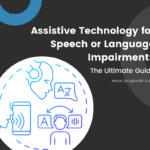Have you or someone you know been struggling with speech or language impairment? Are you looking for ways to improve communication and overcome the daily challenges that come with it? You’re not alone. Many people face similar difficulties, but there is a solution- assistive technology.
In this comprehensive guide, I’ll walk you through everything you need to know about assistive technology for speech or language impairment. From what it is and how it works, to different types of assistive technologies available, and how they can benefit individuals with communication disabilities. As someone who has personally experienced these challenges, I understand the importance of finding the right tools to help enhance communication skills. So let’s get started on this journey together!
So, assistive technology for speech or language impairment?
Speech and language impairments can greatly impact a person’s ability to communicate effectively. Fortunately, there are various assistive technologies available that can help individuals with these impairments overcome communication barriers and improve their overall quality of life.
One such technology is augmentative and alternative communication (AAC) devices. These devices use symbols, pictures, or text to help individuals express themselves when they are unable to do so verbally. They come in different forms such as speech-generating devices, picture boards, and electronic tablets with specialized software.
Another helpful tool for those with speech or language impairments is voice recognition software. This technology allows users to speak into a microphone and have their words translated into written text on a computer screen. It can be particularly useful for those who have difficulty typing or writing due to physical limitations.
For individuals who struggle with understanding spoken language, there are also text-to-speech programs that read aloud written words on a computer or device. This can be beneficial for those with reading difficulties or hearing impairments.
In addition to these specific technologies designed for speech and language impairment, there are also general accessibility features built into many electronic devices such as smartphones and computers. These include options for larger font sizes, voice commands, and predictive text which can aid in communication.
It’s important to note that the effectiveness of assistive technology may vary from person to person depending on the severity of their impairment and individual needs. It’s always best to consult with a specialist who can assess an individual’s unique situation and make recommendations accordingly.
Overall, assistive technology has revolutionized the way people with speech or language impairments communicate by providing them with tools tailored specifically for their needs. With continued advancements in this field, we can hope for even more innovative solutions that will further enhance the lives of those facing these challenges.
Understanding Assistive Technology for Speech or Language Impairment
Assistive technology plays a significant role in helping individuals with speech or language impairments communicate more effectively. This technology ranges from simple tools, like picture boards, to advanced electronic devices that generate speech. For those who might struggle to form words or sentences, augmentative and alternative communication (AAC) systems can be life-changing. These systems often use symbols or images that allow users to express their thoughts without relying on spoken language alone. By simply pointing at an image on a board or tapping on a tablet screen, they can share ideas and feelings in ways that would otherwise be difficult.
Moreover, as we dive deeper into this realm of support, it’s fascinating to see how technology continues to evolve. Think about the rise of apps designed specifically for communication; many are user-friendly and customizable according to individual needs. Some popular features include voice output options which read text aloud—ideal for people who may have difficulty speaking clearly themselves. In addition, these applications often incorporate speech recognition, allowing users’ voices to control their devices with greater ease over time.
Ultimately, assistive technology not only enhances daily interactions but also fosters independence and confidence among individuals facing speech difficulties.
Exploring Different Types of Assistive Technologies and Their Uses for Speech or Language Impairment
Assistive technologies for speech and language impairment come in a variety of forms, each designed to support individuals in communicating more effectively. For instance, there are speech-generating devices (SGDs), which can convert text into spoken words. These devices range from simple button-based tools to advanced tablets with specialized software that enable users to form sentences by selecting images or words. Not only do SGDs help those who struggle with oral communication, but they also foster independence and confidence, allowing users to express their thoughts and feelings freely.
Another fascinating category is augmentative and alternative communication (AAC) systems. AAC includes both low-tech solutions like picture boards or symbol cards and high-tech options like apps on smartphones or tablets that facilitate conversation through dynamic displays. Many of these technologies offer customizable features tailored to the user’s needs, empowering them to engage more fully in social interactions or educational settings. This flexibility means that whether someone is using gestures, pictures, or sophisticated speech apps, they have valuable tools at their disposal for bridging the gap between knowing what they want to say and being able to communicate it clearly. Through innovative advancements in assistive technology, people with speech impairments can find new avenues for self-expression every day!

Read also: ai in speech recognition
Assistive Technology for Speech or Language Impairment: How to Select the Right Assistive Technology for Specific Needs
Choosing the right assistive technology for speech or language impairment can feel overwhelming, but it doesn’t have to be. First, it’s important to identify specific needs by having a thorough assessment from professionals like speech-language pathologists. They can guide you through understanding how communication challenges affect everyday life. Once you know what you’re looking for, consider different types of tools available. These might include devices that allow for text-to-speech, symbol-based communication boards, or apps designed specifically to help with language development. Each option has its unique features and benefits, so exploring these thoroughly is key.
When selecting an assistive device, think about factors such as ease of use and personal preferences. For example, some individuals may benefit from user-friendly tablets with interactive applications that make learning fun and engaging while others might prefer simple voice-output devices that are easy to operate without much technological knowledge. Additionally, ensure the chosen technology fits well into daily routines—whether at school or home—and provides opportunities for social interaction with peers.
Ultimately, involving the person who will use the technology in discussions about their choices can empower them and lead to better outcomes in both communication skills and confidence.
Benefits and Limitations of Using Assistive Technologies in Overcoming Communication Disabilities
Assistive technologies have revolutionized the way individuals with communication disabilities express themselves and connect with others. Tools like speech-generating devices and apps designed for tablets can enable a person to communicate effectively, fostering independence and enhancing their quality of life. For instance, imagine a child who has difficulty speaking but uses an app that allows them to select words or images to form sentences. This not only helps in conveying thoughts but also boosts confidence as they participate in conversations just like their peers. Additionally, some devices allow users to customize responses based on personal interests or experiences, making interactions more meaningful and engaging.
However, while these technologies provide significant advantages, there are also limitations that cannot be overlooked. The reliance on assistive tools can create barriers if they fail due to technical issues or require constant updates—this might leave someone feeling frustrated when trying to communicate. Furthermore, costs associated with purchasing advanced equipment can be prohibitive for many families.
It’s also essential for users and caregivers alike to undergo training so they can maximize the benefits of these tools; without proper knowledge, the potential remains untapped. Balancing these benefits against the drawbacks is crucial in ensuring effective communication support for those who need it most.
You may also like: ai voice detection
The Future of Assistive Technology in Managing Speech or Language Impairments
As we look toward the future, assistive technology is poised to revolutionize how individuals with speech or language impairments communicate. Imagine devices that can learn and adapt to a person’s unique voice patterns, allowing for more natural conversations. Advanced artificial intelligence could analyze speech sounds in real-time, offering personalized feedback and suggestions to users. This means that someone struggling with articulation might receive tailored exercises delivered through a friendly app interface. Over time, these technologies will become smarter, potentially anticipating needs based on past interactions—like reminding a user of specific words or phrases they often struggle with.
Moreover, as virtual reality (VR) becomes more accessible, it holds exciting possibilities for therapy sessions. Picture immersive environments where users can practice speaking in realistic scenarios without fear of judgment. These engaging experiences could boost confidence and make learning enjoyable. With options like speech-generating devices (SGDs) becoming increasingly portable and user-friendly, individuals will have greater opportunities for expression throughout their daily lives—from social events to professional settings. Overall, the landscape of communication aids is brightening significantly; innovations are paving pathways toward inclusivity and empowerment for those facing speech challenges now and into the future.



